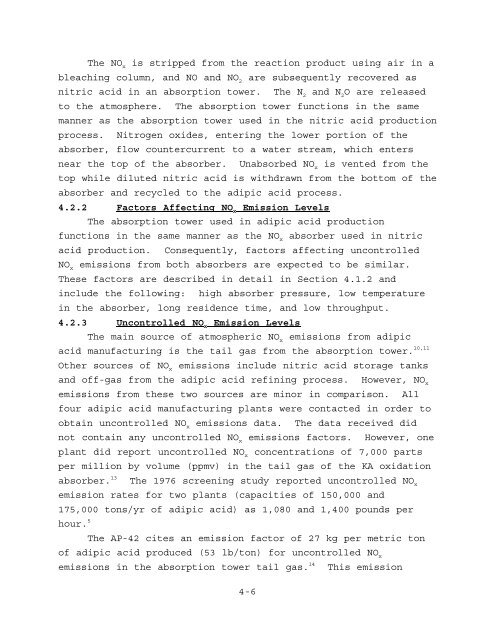Alternative Control Techniques Document— Nitric And Adipic Acid
Alternative Control Techniques Document— Nitric And Adipic Acid
Alternative Control Techniques Document— Nitric And Adipic Acid
You also want an ePaper? Increase the reach of your titles
YUMPU automatically turns print PDFs into web optimized ePapers that Google loves.
The NO is stripped from the reaction product using air in a<br />
x<br />
bleaching column, and NO and NO are subsequently recovered as<br />
2<br />
nitric acid in an absorption tower. The N and N O are released<br />
2 2<br />
to the atmosphere. The absorption tower functions in the same<br />
manner as the absorption tower used in the nitric acid production<br />
process. Nitrogen oxides, entering the lower portion of the<br />
absorber, flow countercurrent to a water stream, which enters<br />
near the top of the absorber. Unabsorbed NO is vented from the<br />
x<br />
top while diluted nitric acid is withdrawn from the bottom of the<br />
absorber and recycled to the adipic acid process.<br />
4.2.2 Factors Affecting NO Emission Levels<br />
x<br />
The absorption tower used in adipic acid production<br />
functions in the same manner as the NO absorber used in nitric<br />
x<br />
acid production. Consequently, factors affecting uncontrolled<br />
NO emissions from both absorbers are expected to be similar.<br />
x<br />
These factors are described in detail in Section 4.1.2 and<br />
include the following: high absorber pressure, low temperature<br />
in the absorber, long residence time, and low throughput.<br />
4.2.3 Uncontrolled NO x Emission Levels<br />
The main source of atmospheric NO x emissions from adipic<br />
10,11<br />
acid manufacturing is the tail gas from the absorption tower.<br />
Other sources of NO emissions include nitric acid storage tanks<br />
x<br />
and off-gas from the adipic acid refining process. However, NO x<br />
emissions from these two sources are minor in comparison. All<br />
four adipic acid manufacturing plants were contacted in order to<br />
obtain uncontrolled NO emissions data. The data received did<br />
x<br />
not contain any uncontrolled NO emissions factors. However, one<br />
x<br />
plant did report uncontrolled NO concentrations of 7,000 parts<br />
x<br />
per million by volume (ppmv) in the tail gas of the KA oxidation<br />
13<br />
absorber. The 1976 screening study reported uncontrolled NOx<br />
emission rates for two plants (capacities of 150,000 and<br />
175,000 tons/yr of adipic acid) as 1,080 and 1,400 pounds per<br />
hour. 5<br />
The AP-42 cites an emission factor of 27 kg per metric ton<br />
of adipic acid produced (53 lb/ton) for uncontrolled NOx 14<br />
emissions in the absorption tower tail gas. This emission<br />
4-6

















